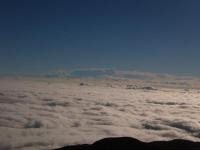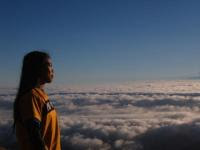1. Mummy shape.
2. Down filled.
3. Baffle inner construction.
4. More loft equals more warmth.
5. Large cowl and draw string around the head.
6. Thick baffle along the zip or no zip at all.
Sleeping-bags are a very important part of a mountain-walker’s equipment as they will be the main source of warmth during the coldest times of the night. They differ in two main areas – firstly in shape and secondly in what they are filled with.
Shape
They are basically either a rectangular or a “mummy” type shape. The rectangular type has a larger area around the legs, making for a more comfortable and looser feel. It is also easier to manufacture and thus cheaper in price. However this shape also means that there is more area your body has to heat up (so you will be colder) and more fabric used which makes it heavier than necessary. Mummy type bags on the other hand are tapered towards the feet and are warmer, lighter and are the preferred shape for most hikers and mountaineers.
Filling
The filling inside a sleeping-bag gives the bag loft, which is the amount of thickness or fluffiness of the layers when un-rolled. This gives a good indication of how much warmth the bag potentially can retain. The more loft, the warmer the bag. The warm air is trapped by the filling – fine pieces of down-feather or holofibre.
The filling inside a sleeping bag can be divided into 3 main types: cheap synthetic, holofibre and down (fine feathers). Synthetic filling is usually cheap in price, not very warm and quite heavy. It is therefore not really an option for hikers. Holofibre is a better type of synthetic filling made of very fine hollow filaments that trap air inside them and between them. It is a fairly warm filling and retains its warmth when wet. They have a life span of about 10 years if they are looked after. It has the advantage of being cheaper than down, however, it will not compress as well as down and is also heavier. Down, on the other hand is the first choice for high quality sleeping bags. Down consists of the very fine feathers found on the breast area of geese. Some sleeping bags use a lower quality of down consisting of larger feathers. These feathers can be felt when handling the bag and indicates a lower quality and less warmth of the product.
Good quality down bags are light, have more warmth per weight of filling, compress more easily and lasts a lifetime if looked after properly. The disadvantages are that they loose most of their warmth when wet, are hard to get dry and more expensive. The advantages of down far out weigh the disadvantages, making down the preferred choice in most instances.
Internal construction
The internal construction of sleeping-bags is very important. In both holofibre and down bags there are two major design types. These are sewn-through type construction and a baffle type construction. Both these construction types are to create separate compartments so that the filling does not shift around and remains fairly evenly spread throughout the bag. The sewn-though type allows for warmth to escape through the constricted areas where the inner and outer pieces of fabric are brought together. This is a major disadvantage and is not used on well-constructed sleeping bags. Baffle type bags have compartments where the two layers of fabric are kept apart by a separate inner wall. These compartments have different designs, which could be a zigzag pattern or a rectangular shape, depending on the manufacture.
Sewn through construction Zigzag baffle type

Sewn through construction Zigzag baffle type
Cowls and hoods
Good quality sleeping-bags also have additional features such as cowls or hoods, which can be pulled over the head and shoulder area and semi-waterproof outer material. If they have a zip, the zip area will have thick baffle to prevent warmth escaping.
First Ascent make a good range of sleeping bags. These include:
*
Fusion 900 – very cold conditions -15C (High altitude -Andes, Kilimanjaro)
*
Fusion 600 – for fairly cold conditions -5C (Top of the Drakensberg in winter)
*
Adventure Light – summer hiking at low altitude in southern Africa +5C.
*
Ice breaker – summer hiking +8C.
Washing a down sleeping-bag:
1. Down filled sleeping-bags need to be washed once in a while. Washing them cleans the bag and also revives the “loft”, bringing back the product's ability to keep you warm. It is a long process, but is worth the effort for getting a “new” and warm sleeping bag.
2. Place the bag in a bath of lukewarm water. Add down-soap manufactured by Nikwax or First Ascent. Follow the instructions and measures required. Move the bag around gently and rub where needed. Rinse the bag out 3 times in cold water or until the water runs clear. Gently press the water out with your hands. Do not “wring” the water out, as this could tear the inner baffles.
3. Then hang the bag in a warm, dry and preferably windy area (but not in the sun). Leave it there until most of the water has drained. Then place in a tumble dryer on low heat. It is good to put some tennis balls into the dryer also. These help to get the down to loosen up and dry properly. Every 30 minutes or so, take the bag out and shake it out well. Keep drying until the loft has been obtained. Note: The bag will remain very soggy and flat for a long time. It will seem to suddenly dry and return to its proper shape. Follow the same procedures if washing a down-jacket.













No comments:
Post a Comment